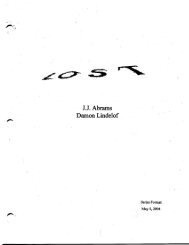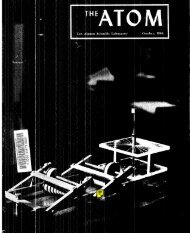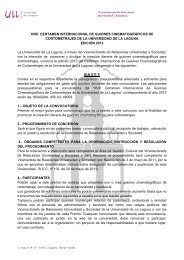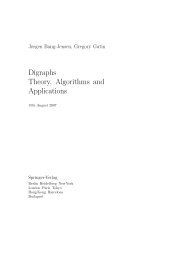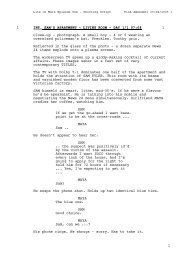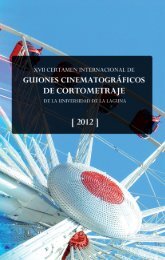You also want an ePaper? Increase the reach of your titles
YUMPU automatically turns print PDFs into web optimized ePapers that Google loves.
negative if the image is located in<br />
front of the lens. Converging lenses<br />
(thicker in the center than at the<br />
edges) have positive l, while diverging<br />
lenses (thinner at the center)<br />
have negative /.<br />
Another useful relationship is the<br />
lens maker's formula. For the special<br />
case when one of the surfaces is planar,<br />
it tells us that<br />
1= r_r<br />
f R'<br />
where n is the index of refraction of<br />
the lens material andR is the radius<br />
o{ the curved surface.<br />
Now that we have completed this<br />
very brief review, let's take a look at<br />
our problem. A concave mirror of<br />
radius R resting face up on a table<br />
top has been filled with a small<br />
amount of water (index of refraction<br />
n = alSl as shown in the figure below.<br />
A small object is located a distanced<br />
= SRIZfromthe mirror along<br />
the optic axis. Where is the image 1ocated?<br />
In the spirit of the "thin lens<br />
approximation" often used in such<br />
problems, we will neglect the thickness<br />
of the water.<br />
A. Let's begin by using a technique<br />
used by eye doctors. Often the<br />
doctor will place a lens in front of<br />
your glasses to show you how the<br />
new lenses will work. This works<br />
because the effective focal length f'<br />
of two (or more) lenses (or mirrors)<br />
in close proximity is given by<br />
t _rr I<br />
f,- L f,<br />
is, the focal lengths add as re-<br />
-that<br />
ciprocals. Therefore, the mirrorwater<br />
combination can be replaced<br />
by a mirror with an effective focal<br />
length and you can use the mirror<br />
formula given above. Does the water<br />
lens appear in the sum once or<br />
twice? Use the other methods to<br />
check yourself.<br />
B. You can also obtain the effective<br />
focal length by tracing aray parallel<br />
to the optic axis as it enters the<br />
water and bends according to Snell's<br />
law, reflects from the mirror surface,<br />
and exits the water again. Don't forget<br />
to make suitable approximations.<br />
C. Our third method makes use<br />
of the observation that images<br />
formedby one optical element act as<br />
objects for subsequent optical elements.<br />
Begin by finding the location<br />
of the image formed by the air-water<br />
interface. Use this image as the object<br />
for the mirror (without the water)<br />
and find the new image location.<br />
Then find the image of this image<br />
formed by the water-air interface<br />
when the light exits the water. This<br />
is the finai image produced by the<br />
combination.<br />
D. The trickiest method treats<br />
the combination as a water lens, a<br />
mirror, and a water lens in combination.<br />
Find the location of the image<br />
produced by each element and then<br />
use it as the object for the next element.<br />
This is trickybecause it's very<br />
easy to make mistakes with the sign<br />
conventions.<br />
Please send your solutions to<br />
Quantum, 1840 Wilson Boulevard,<br />
Arlington VA2220l-3000 within a<br />
month of receipt of this issue. The<br />
best solutions will be noted in this<br />
space and their authors will receive<br />
special certificates from Quantum.<br />
Shp on red, Uo on Ul'solt...<br />
Quantum readers were asked to<br />
determine when it's sa{e to go<br />
through a yellow light and when it's<br />
safe to apply the brakes at the yellow<br />
light. We hope many of our<br />
readers thought about the problem<br />
as they waited at an intersection for<br />
the light to change.<br />
An excellent solution was submitted<br />
by Ophir Yoktan of Israel.<br />
Unfortunately, Yoktan provided no<br />
biographical information and so we<br />
don't know if Yoktan is a professor<br />
or a student. Irrespective of that, the<br />
solution presented here closely follows<br />
Yoktan's submission.<br />
A. (a) In the "go zofle" a person<br />
wi1lbe able to continue at the traveling<br />
speed and get through the intersection<br />
within the time that the<br />
yellow iight is illuminated. This<br />
depends on the velocity of the clt vst<br />
the yellow light time t.,,, the width of<br />
the intersection ra4, ancl the length of<br />
the carl. (The go zone is cluite different<br />
for a stretch limo and a compact<br />
car.) This gives us<br />
drv^t Ur<br />
--z ,o<br />
-2,<br />
(c) Whether we have a "dilemma<br />
zolne" or an "overlap zofre" depends<br />
on the difference between the go<br />
zone and the stop zone.If the zone<br />
is defined as the go zone minus the<br />
stop zone, a negative value will indicate<br />
a dilemma zone and a positive<br />
value will indicate an overlap zone:<br />
zone = voty -w - 1-votr+fi<br />
1"t<br />
=<br />
*"'r* (r, - ,,)ro-(w+ /).<br />
B. We can find the conditions for<br />
which there will always be a dilemma<br />
zoneby requiring that the<br />
zone be negative:<br />
o, j"'o* (r, - r,)ro - @ + 1).<br />
See the equation in the box on the<br />
next page. A dilemma zone willalways<br />
exist if the terms within the<br />
radical sign are negative. This occurs<br />
34<br />
Jllr.Y/[tl0l|$T rg04



